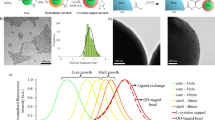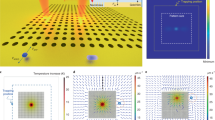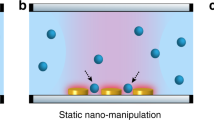Abstract
Advances in optical tweezers, coupled with the proliferation of two-photon polymerization systems, mean that it is now becoming routine to fabricate and trap non-spherical particles. The shaping of both light beams and particles allows fine control over the flow of momentum from the optical to mechanical regimes. However, understanding and predicting the behaviour of such systems is highly complex in comparison with the traditional optically trapped microsphere. In this Article, we present a conceptually new and simple approach based on the nature of the optical force density. We illustrate the method through the design and fabrication of a shaped particle capable of acting as a passive force clamp, and we demonstrate its use as an optically trapped probe for imaging surface topography. Further applications of the design rules highlighted here may lead to new sensors for probing biomolecule mechanics, as well as to the development of optically actuated micromachines.
This is a preview of subscription content, access via your institution
Access options
Subscribe to this journal
Receive 12 print issues and online access
$209.00 per year
only $17.42 per issue
Buy this article
- Purchase on Springer Link
- Instant access to full article PDF
Prices may be subject to local taxes which are calculated during checkout



Similar content being viewed by others
References
Ashkin, A., Dziedzic, J., Bjorkholm, J. & Chu, S. Observation of a single-beam gradient force optical trap for dielectric particles. Opt. Lett. 11, 288–290 (1986).
Block, S. M., Goldstein, L. S. & Schnapp, B. J. Bead movement by single kinesin molecules studied with optical tweezers. Nature 348, 348–352 (1990).
Glückstad, J. Optical manipulation: sculpting the object. Nature Photon. 5, 7–8 (2010).
Simpson, S. H. & Hanna, S. Stability analysis and thermal motion of optically trapped nanowires. Nanotechnology 23, 205502 (2012).
Galajda, P. & Ormos, P. Rotors produced and driven in laser tweezers with reversed direction of rotation. Appl. Phys. Lett. 80, 4653–4655 (2002).
La Porta, A. & Wang, M. D. Optical torque wrench: angular trapping, rotation, and torque detection of quartz microparticles. Phys. Rev. Lett. 92, 190801 (2004).
Jannasch, A., Demirörs, A. F., van Oostrum, P. D., van Blaaderen, A. & Schäffer, E. Nanonewton optical force trap employing anti-reflection coated, high-refractive-index titania microspheres. Nature Photon. 6, 469–473 (2012).
Swartzlander G. A. Jr, Peterson, T. J., Artusio-Glimpse, A. B. & Raisanen, A. D. Stable optical lift. Nature Photon. 5, 48–51 (2010).
Simpson, S. H., Hanna, S., Peterson, T. J. & Swartzlander, G. A. Optical lift from dielectric semicylinders. Opt. Lett. 37, 4038–4040 (2012).
Bishop, A. I., Nieminen, T. A., Heckenberg, N. R. & Rubinsztein-Dunlop, H. Optical microrheology using rotating laser-trapped particles. Phys. Rev. Lett. 92, 198104 (2004).
Trojek, J., Karasek, V. & Zemanek, P. Extreme axial optical force in a standing wave achieved by optimized object shape. Opt. Express 17, 10472–10488 (2009).
Palima, D. et al. Wave-guided optical waveguides. Opt. Express 20, 2004–2014 (2012).
Nieminen, T. A. et al. Optical tweezers computational toolbox. J. Opt. A 9, S196–S203 (2007).
Bowman, R. W. & Padgett, M. J. Optical trapping and binding. Rep. Prog. Phys. 76, 026401 (2013).
Pfeifer, R. N., Nieminen, T. A., Heckenberg, N. R. & Rubinsztein-Dunlop, H. Colloquium: momentum of an electromagnetic wave in dielectric media. Rev. Mod. Phys. 79, 1197 (2007).
Mansuripur, M. & Zakharian, A. R. Radiation pressure on a submerged absorptive partial reflector deduced from the Doppler shift. Phys. Rev. A 86, 013841 (2012).
Brevik, I. Experiments in phenomenological electrodynamics and the electromagnetic energy-momentum tensor. Phys. Rep. 52, 133–201 (1979).
Brevik, I. & Ellingsen, S. Transverse radiation force in a tailored optical fiber. Phys. Rev. A 81, 011806 (2010).
Van Bladel, J. Singular Electromagnetic Fields and Sources (Clarendon, 1991).
Simmons, R. M., Finer, J. T., Chu, S. & Spudich, J. A. Quantitative measurements of force and displacement using an optical trap. Biophys. J. 70, 1813–1822 (1996).
Phillips, D. et al. Optimizing the optical trapping stiffness of holographically trapped microrods using high-speed video tracking. J. Opt. 13, 044023 (2011).
Cumpston, B. H. et al. Two-photon polymerization initiators for three-dimensional optical data storage and microfabrication. Nature 398, 51–54 (1999).
Bowman, R., Gibson, G. & Padgett, M. Particle tracking stereomicroscopy in optical tweezers: control of trap shape. Opt. Express 18, 11785–11790 (2010).
Phillips, D. B. et al. An optically actuated surface scanning probe. Opt. Express 20, 29679–29693 (2012).
Wang, F. et al. Resolving stable axial trapping points of nanowires in an optical tweezers using photoluminescence mapping. Nano Lett. 13, 1185–1191 (2013).
Ghislain, L. P. & Webb, W. W. Scanning-force microscope based on an optical trap. Opt. Lett. 18, 1678–1680 (1993).
Friese, M. E. J., Truscott, A. G., Rubinsztein-Dunlop, H. & Heckenberg, N. R. Three-dimensional imaging with optical tweezers. Appl. Opt. 38, 6597–6603 (1999).
Seitz, P. C., Stelzer, E. H. K. & Rohrbach, A. Interferometric tracking of optically trapped probes behind structured surfaces: a phase correction method. Appl. Opt. 45, 7309–7315 (2006).
Phillips, D. B. et al. Surface imaging using holographic optical tweezers. Nanotechnology 22, 285503 (2011).
Simpson, S. H., Phillips, D. B., Carberry, D. M. & Hanna, S. Bespoke optical springs and passive force clamps from shaped dielectric particles. J. Quant. Spectrosc. Radiat. Transf. 126, 91–98 (2012).
Greenleaf, W. J., Woodside, M. T., Abbondanzieri, E. A. & Block, S. M. Passive all-optical force clamp for high-resolution laser trapping. Phys. Rev. Lett. 95, 208102 (2005).
Palima, D. et al. Optical forces through guided light deflections. Opt. Express 21, 581–593 (2013).
Maragò, O. M., Jones, P. H., Gucciardi, P. G., Volpe, G. & Ferrari, A. C. Optical trapping and manipulation of nanostructures. Nature Nanotech. 8, 807–819 (2013).
Mishchenko, M. I., Hovenier, J. W. & Travis, L. D. Light Scattering by Nonspherical Particles: Theory, Measurements, and Applications (Academic, 1999).
Kahnert, F. M. Numerical methods in electromagnetic scattering theory. J. Quant. Spectrosc. Radiat. Transf. 79, 775–824 (2003).
Hafner, C. The Generalized Multipole Technique for Computational Electromagnetics (Artech House, 1990).
Nieminen, T., Rubinsztein-Dunlop, H. & Heckenberg, N. Calculation of the T-matrix: general considerations and application of the point-matching method. J. Quant. Spectrosc. Radiat. Transf. 79, 1019–1029 (2003).
Lock, J. A. & Gouesbet, G. Rigorous justification of the localized approximation to the beam-shape coefficients in generalized Lorenz–Mie theory. I. On-axis beams. J. Opt. Soc. Am. A 11, 2503–2515 (1994).
Chen, J., Ng, J., Lin, Z. & Chan, C. Optical pulling force. Nature Photon. 5, 531–534 (2011).
Pfeifer, R. N., Nieminen, T. A., Heckenberg, N. R. & Rubinsztein-Dunlop, H. Optical tweezers and paradoxes in electromagnetism. J. Opt. 13, 044017 (2011).
Carrasco, B. & García de la Torre, J. Hydrodynamic properties of rigid particles: comparison of different modeling and computational procedures. Biophys. J. 76, 3044–3057 (1999).
Phillips, D. B. et al. Optical Trapping and Optical Micromanipulation X 8810-80 (SPIE, 2013).
Acknowledgements
This work was funded through the Engineering and Physical Sciences Research Council, UK (grant nos. EP/I010785/1 and EP/I007822/1). It was carried out with the support of the Bristol Centre for Nanoscience and Quantum Information and using the computational facilities of the Advanced Computing Research Centre, University of Bristol (http://www.bris.ac.uk/acrc/). The authors thank J. Rarity for the use of the Nanoscribe Photonic Professional direct write laser lithography system for structure fabrication, and Sarah Dolan for support with illustrations. M.J.M. and M.J.P. acknowledge Royal Society Wolfson Merit Awards.
Author information
Authors and Affiliations
Contributions
D.B.P. fabricated the structures and designed and performed all experiments and analysis. S.H.S. formulated the concept of relating shape to optical force and performed all theoretical calculations, with support from S.H. Y.-L.D.H. assisted with structure fabrication. M.J.P. provided support to the optical tweezers apparatus. M.J.M., M.J.P. and D.M.C. developed the concept of the scanning probe application. S.H.S., D.B.P. and S.H. wrote the paper, and all other authors provided editorial input.
Corresponding author
Ethics declarations
Competing interests
The authors declare no competing financial interests.
Supplementary information
Supplementary information
Supplementary information (PDF 264 kb)
Rights and permissions
About this article
Cite this article
Phillips, D., Padgett, M., Hanna, S. et al. Shape-induced force fields in optical trapping. Nature Photon 8, 400–405 (2014). https://doi.org/10.1038/nphoton.2014.74
Received:
Accepted:
Published:
Issue Date:
DOI: https://doi.org/10.1038/nphoton.2014.74
This article is cited by
-
Reconfigurable multi-component micromachines driven by optoelectronic tweezers
Nature Communications (2021)
-
Towards non-blind optical tweezing by finding 3D refractive index changes through off-focus interferometric tracking
Nature Communications (2021)
-
Indirect optical trapping using light driven micro-rotors for reconfigurable hydrodynamic manipulation
Nature Communications (2019)
-
Direct measurement of optical trapping force gradient on polystyrene microspheres using a carbon nanotube mechanical resonator
Scientific Reports (2017)
-
Tomographic active optical trapping of arbitrarily shaped objects by exploiting 3D refractive index maps
Nature Communications (2017)



